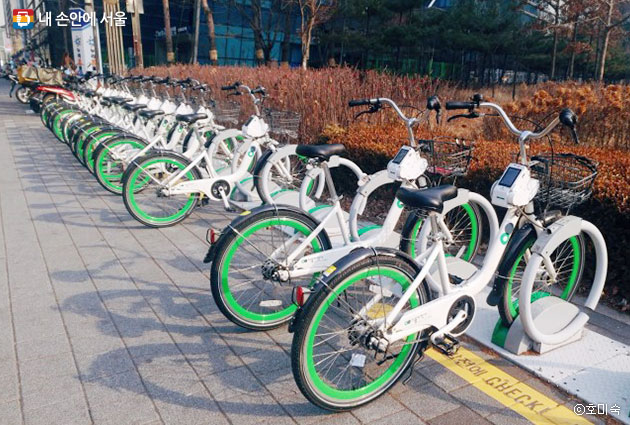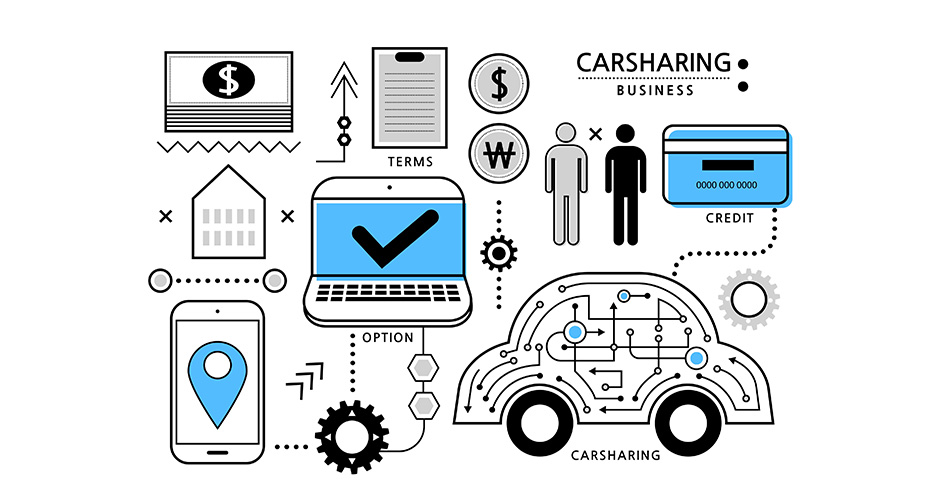List
Story > NEWS > Detail
[News] Background of Transportation Service in Shared Economy
The beginning of shared economy transportation services can be seen as a public bicycle. In the late 2000s, climate change and energy depletion began to be seriously contemplated around the world and efforts began to be made to prepare for it. As promoting the use of bicycles, a carbon-free transportation, was considered one of the tasks of the transportation sector, cities around the world began to introduce public bicycles competitively. What's different from the past is that by renting bicycles with IC smart cards using chips, the identity and personal information of the bikers can be identified and GPS devices can be attached to the bikes to manage them in real time. In other words, the technology has solved the biggest problem of the public bicycle: theft and repurposing.

The most notable of the shared economy-type transportation services would be car-sharing and ride-sharing. The first car-sharing service is known as the Community Service of Switzerland in the 1950s. Commercial car-sharing services were introduced around the late 1990s when Internet penetration began to activate. As automatic reservation through internet is possible in real time, it can be seen that service is possible. It was not until late 2000 that it was more than 10 years later that it was able to break even, which is consistent with the time when smartphones appeared. Because location-based services have become available and upgraded in real time with the advent of smartphones, convenience of use has been greatly improved. In addition, the late 2000s were in line with the onset of the global financial crisis, which resulted in a large increase in the number of economically weak people who could not afford to spend their cars for a certain period of time, resulting in a significant increase in the demand for access to niche markets. In other words, the explosive growth of the car-sharing market in the late 2000s can be attributed to the emergence of niche markets due to the economic crisis and the advent of smartphones, which made the service technically feasible.

Uber, referred to as the RideSharing service, began its service in 2010 and grew exponentially around the world as soon as it started, which is also similar to the reason behind the growth of the car-sharing service. It is the same thing that the economic crisis has caused the loss of normal jobs or a sharp increase in the number of extra workers who need extra income, and that real-time location-based services through smartphones have become possible. Adding one more cause to this would be dissatisfaction with the existing taxi service. The service is not very good in most countries and cities because they regulate the supply and rates of taxis. This has been a constant build-up of complaints from users, as taxi services have failed to keep up with the increased demands and expectations of users.

Let's find out more about the characteristics of shared economy-type transportation services. While the existing public transportation means and taxis can be regarded as a shared economy-type transportation service, the government will limit the public economy-type transportation service to the following traffic services. First, traffic services that can reduce greenhouse gas emissions and energy consumption, second traffic services that can provide economic benefits to users, and third traffic services that overcome limitations of existing services can be cited as their characteristics.

The biggest experiment in proving the usefulness of a shared economy in the transportation sector is car-sharing. The car-sharing system started in Europe and spread to the U.S., and has been rapidly spreading since 2008, when the U.S. economic crisis hit the country. Zipcar's success in the U.S. has already been known, but in Korea, the number of Seoul Nanum Car users has been increasing rapidly since its introduction in February 2013 by more than 400 percent over the past three years, and it has a great effect of supplementing public transportation in areas, time zones and weekends where public transportation is inconvenient.
Meanwhile, efforts are underway to maximize synergy from sharing by establishing a system linking shared-based transportation services. For example, a system of connection between individual participants of shared services such as discount benefits when using a shared parking lot if they participate in car-sharing more than a certain number of times, or discounts on car-sharing fees if they share a bicycle. On the other hand, by making goods cheaper for car-sharing members or by allowing them to use the points they buy and accumulate at department stores for cheap use of shared transportation services, the synergy effect of the integrated system can be maximized by linking them with ordinary economic activities.
This time, we looked at the background of shared economy-type transportation services. In addition, some of the most successful cases of transportation services in the U.S. economy were found to be possible by looking at some of the cases of ride-sharing and car-sharing. Since each country has different positions and laws on shared economy-type transportation services, the pace of their development can be considered different. Nevertheless, it goes without saying that if the government is determined to resolve the problem of transportation services steadily, it is possible that the shared economy-type transportation services will develop further in the future.
The beginning of shared economy transportation services can be seen as a public bicycle. In the late 2000s, climate change and energy depletion began to be seriously contemplated around the world and efforts began to be made to prepare for it. As promoting the use of bicycles, a carbon-free transportation, was considered one of the tasks of the transportation sector, cities around the world began to introduce public bicycles competitively. What's different from the past is that by renting bicycles with IC smart cards using chips, the identity and personal information of the bikers can be identified and GPS devices can be attached to the bikes to manage them in real time. In other words, the technology has solved the biggest problem of the public bicycle: theft and repurposing.

The most notable of the shared economy-type transportation services would be car-sharing and ride-sharing. The first car-sharing service is known as the Community Service of Switzerland in the 1950s. Commercial car-sharing services were introduced around the late 1990s when Internet penetration began to activate. As automatic reservation through internet is possible in real time, it can be seen that service is possible. It was not until late 2000 that it was more than 10 years later that it was able to break even, which is consistent with the time when smartphones appeared. Because location-based services have become available and upgraded in real time with the advent of smartphones, convenience of use has been greatly improved. In addition, the late 2000s were in line with the onset of the global financial crisis, which resulted in a large increase in the number of economically weak people who could not afford to spend their cars for a certain period of time, resulting in a significant increase in the demand for access to niche markets. In other words, the explosive growth of the car-sharing market in the late 2000s can be attributed to the emergence of niche markets due to the economic crisis and the advent of smartphones, which made the service technically feasible.

Uber, referred to as the RideSharing service, began its service in 2010 and grew exponentially around the world as soon as it started, which is also similar to the reason behind the growth of the car-sharing service. It is the same thing that the economic crisis has caused the loss of normal jobs or a sharp increase in the number of extra workers who need extra income, and that real-time location-based services through smartphones have become possible. Adding one more cause to this would be dissatisfaction with the existing taxi service. The service is not very good in most countries and cities because they regulate the supply and rates of taxis. This has been a constant build-up of complaints from users, as taxi services have failed to keep up with the increased demands and expectations of users.

Let's find out more about the characteristics of shared economy-type transportation services. While the existing public transportation means and taxis can be regarded as a shared economy-type transportation service, the government will limit the public economy-type transportation service to the following traffic services. First, traffic services that can reduce greenhouse gas emissions and energy consumption, second traffic services that can provide economic benefits to users, and third traffic services that overcome limitations of existing services can be cited as their characteristics.

The biggest experiment in proving the usefulness of a shared economy in the transportation sector is car-sharing. The car-sharing system started in Europe and spread to the U.S., and has been rapidly spreading since 2008, when the U.S. economic crisis hit the country. Zipcar's success in the U.S. has already been known, but in Korea, the number of Seoul Nanum Car users has been increasing rapidly since its introduction in February 2013 by more than 400 percent over the past three years, and it has a great effect of supplementing public transportation in areas, time zones and weekends where public transportation is inconvenient.
Meanwhile, efforts are underway to maximize synergy from sharing by establishing a system linking shared-based transportation services. For example, a system of connection between individual participants of shared services such as discount benefits when using a shared parking lot if they participate in car-sharing more than a certain number of times, or discounts on car-sharing fees if they share a bicycle. On the other hand, by making goods cheaper for car-sharing members or by allowing them to use the points they buy and accumulate at department stores for cheap use of shared transportation services, the synergy effect of the integrated system can be maximized by linking them with ordinary economic activities.
This time, we looked at the background of shared economy-type transportation services. In addition, some of the most successful cases of transportation services in the U.S. economy were found to be possible by looking at some of the cases of ride-sharing and car-sharing. Since each country has different positions and laws on shared economy-type transportation services, the pace of their development can be considered different. Nevertheless, it goes without saying that if the government is determined to resolve the problem of transportation services steadily, it is possible that the shared economy-type transportation services will develop further in the future.



